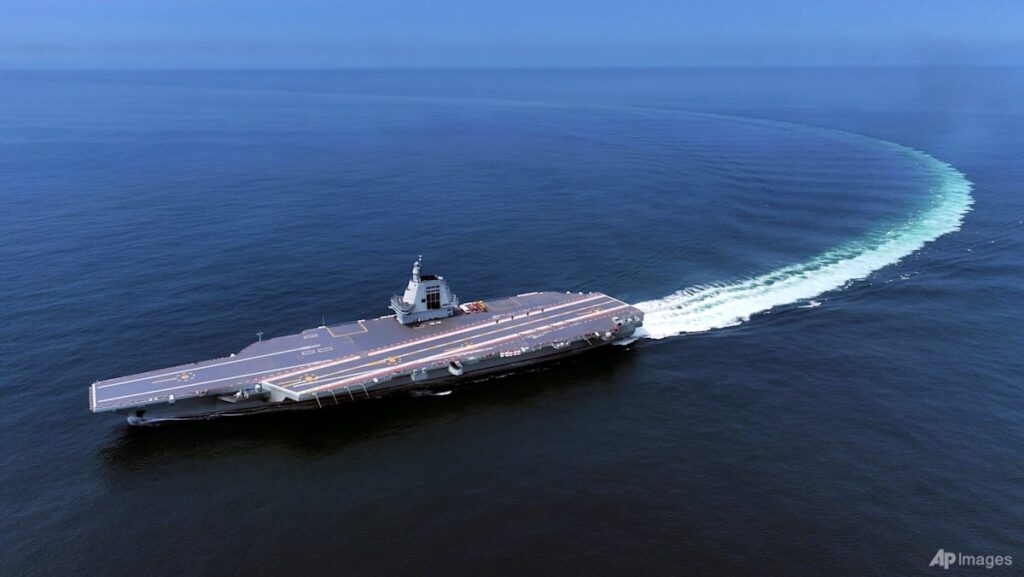CHINA’S AIRCRAFT CARRIERS
The Fujian has a flat flight deck and electromagnetic catapults for take-offs, making it potentially far more powerful than China’s first two Russian-designed carriers.
The Liaoning and Shandong carriers are smaller and rely on ramps to launch aircraft.
The Fujian skips past the steam catapult technology used on most American carriers to employ an electromagnetic launch system found only on the latest US Navy Ford-class carriers.
The system causes less stress to the aircraft and the ship, allows for more precise control over speed and can launch a wider range of aircraft than the steam system.
Compared to the older ski-jump system, it gives China the ability to launch heavier aircraft, with full fuel loads, like the KJ-600 early warning and control plane, which it successfully tested during its sea trials.
Its latest J-35 stealth fighter and J-15T heavy fighter were also launched from the Fujian, giving the new carrier “full-deck operation capability” according to the Chinese navy.
The ability to carry its own reconnaissance aircraft means, unlike its first two carriers, it won’t be operating blind when out of the range of land-based support, giving it the ability to operate its most advanced aircraft far afield, including the Second Island Chain – where the US has important military facilities on Guam and elsewhere.
The Pentagon’s annual report on China’s military modernisation, released last December, noted that the Fujian and future similar carriers would boost China’s ability to project military power, in part through deploying highly specialised electronic warfare and anti-submarine aircraft.
“This will increase the striking power of a potential People’s Liberation Army Navy carrier battle group when deployed to areas beyond (China’s) immediate periphery,” it said.
CHINA’S NAVY LAGS BEHIND THE US
Regional military attaches and analysts say they will be watching upcoming deployments, trying to gauge how quickly the Fujian is able to become combat-ready by monitoring flight operations and efforts to combine its operations with support ships and submarines.
“I think it will be at least another year before it reaches full operational capability,” said Ben Lewis, founder of open source data platform PLATracker.
“Despite nine sea trials this year, they are working with almost entirely new platforms top to bottom,” Lewis said ahead of Friday’s announcement.
An analyst noted that China’s navy lags behind the US in several significant ways.
Numerically, China only has three carriers compared to the US Navy’s 11, and while China’s carriers are all conventionally powered, the US’ are all nuclear powered, which means they can operate almost indefinitely without being refuelled – dramatically increasing their range.
China also lags behind the US in guided missile cruisers and destroyers, which are critical in providing air and submarine defence and support for larger naval groups, as well as nuclear-powered submarines.
The US is ahead in vertical launching system cells, though China is increasing that capacity, said Brian Hart, deputy director of CSIS’s China Power Project.
China also lacks the network of overseas bases that the US has, which are critical for resupplying carriers and also providing alternative runways should aircraft not be able to return safely to the carrier.
The country is working on expanding its foreign bases, however, and has a nuclear propulsion system for a carrier in development.
There’s also evidence that China is already building another carrier. Chinese shipyards have the capabilities to build more than one at once and have also been churning out other new vessels at a pace the US can’t currently come close to matching.
“Really across the board, China’s closing the gap,” Hart said.
“They’re fielding and building more aircraft carriers, they’re fielding more nuclear-powered subs, they are fielding more, larger destroyers and other vessels that carry a larger number of missiles. So they’re really catching up.”
Read the full article here

